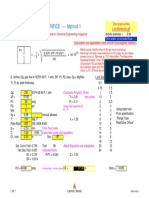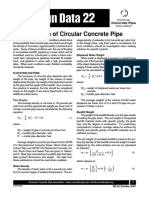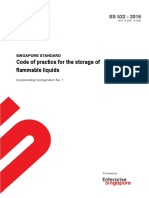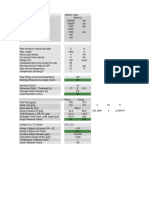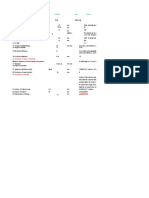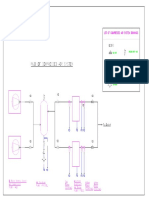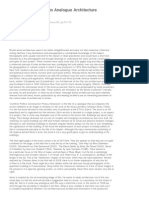Lighting Calcs
Uploaded by
alvinchuanLighting Calcs
Uploaded by
alvinchuanLighting Science, Theory and Calculations
________________________________________________________________________
SECTION 1
LIGHTING SCIENCE, THEORY AND CALCULATIONS
Contents:
Section 1.1
Introduction
Section 1.
Visible Spectrum
Section 1.3
Light Sources
Section 1.4
Lighting Theory
Section 1.5
Laws of Light
Section 1.6
Point Source Calculations
Section 1.7
Transmittance, Reflectance, Absorption
and Indirect Lighting Schemes
Section 1.8
Illuminance and Visual Performance
Section 1.9
Lumen Method of Light Calculation
Section 1.10
Uplighting Calculations
________________________________________________________________________
Interior Lighting Design - A Student's Guide
KK/KO'C 97
Lighting Science, Theory and Calculations
10
________________________________________________________________________
SECTION 1 - LIGHTING SCIENCE
1.1 INTRODUCTION
Light is the visible part of the electromagnetic spectrum. Light radiates and can
travel unlimited distances through space. Light rays can however, be reflected,
transmitted or absorbed when they strike an object. The visible spectrum is only a
small part of the full electromagnetic spectrum (see figure 1.1a). The main
source of our natural light is the sun, which has a core temperature of
approximately 10,000,000 K but a surface temperature which is a relatively cool
6,000 K. It is this surface temperature which determines the energy levels at the
different frequencies of the electromagnetic spectrum.
Figure 1.1a shows a graph of electromagnetic energy transmitted by a black body
at 6000 K across the frequency spectrum. The visible spectrum is the frequency
span between 380 nm and 720nm.
ELECTROMAGNETIC SPECTRUM
Cosmic
Rays
Gamma
Rays + X
Rays
Ultra
Violet
Visible
Spectrum
380nm
Infra Red
Radar
T.V. + Radio
720nm
6000 K
Energy
Visible
Spectrum
380
720
Wavelength
Fig 1.1a
1.2
THE VISIBLE SPECTRUM
________________________________________________________________________
Interior Lighting Design - A Student's Guide
KK/KO'C 97
Lighting Science, Theory and Calculations
11
________________________________________________________________________
Energy levels and
colour distribution
380 nm
720 nm
Ultra Violet Indigo Blue
Violet
Green Yellow Orange Red
Infra
Red
Fig. 1.1b
Consider the effect of heating a piece of
soft iron in a fire. If the iron is heated
for a short time, it will radiate heat
energy (curve 1). This radiation is not
visible. If the iron is heated further it
will glow red (curve 2), then white
(curve 3) and eventually blue (curve 4).
Visible
Spectrum
Blue
4
White
3 Red
2
1
Infra Red
The radiation peaks have moved across
the spectrum from red to blue as the
temperature increases and have
increased in magnitude.
Surprisingly, blue is produced at a
higher temperature than red even though
psychologically, we consider blue to be a cool colour and red a warm colour.
White of course, is a mixture of all the colours in the spectrum.
Fig. 1.2
1.3 LIGHT SOURCES
________________________________________________________________________
Interior Lighting Design - A Student's Guide
KK/KO'C 97
Lighting Science, Theory and Calculations
12
________________________________________________________________________
Light from natural sources such as the sun is known as white light and is made
up from the different frequency components of the visible spectrum.
Artificial light from sources such as
candles, tungsten filaments and gas
discharge lamps, etc., has a different
mix of frequency components which
produce a different colour light This is
red
orange also true for indirect natural light which
yellow has been reflected or refracted and where
green some of the colour components have
blue
been absorbed in the process. The
indigo
constituent colours in a beam of light
violet
can be seen by passing the light through
a glass prism (Fig. 1.3).
Glass prism
White light
Source
Fig. 1.3
Sensitivity of human eye
380nm
720nm
Fig. 1.4
Output of SOX lamp
The human eye has evolved over
millennia under the influence of natural
light. Figure 1.4. shows the sensitivity of
the eye to different frequencies. This
can be seen to follow closely the wave
energy profile shown in Fig.1.1b. The
eye therefore, is most sensitive to
colours at the centre of the visible
spectrum.
Discharge lamps have concentrated
outputs at or near the centre of the
visible spectrum to improve their
efficiency, or to use a more exact
lighting term, their efficacy. (See Fig.
1.5)
A low pressure sodium vapour (SOX)
lamp for example, has a very high
efficacy - up to 180 lumens per watt
because its output is concentrated at the
380nm
720nm
centre of the spectrum. It is not,
Fig. 1.5
however, capable of rendering colours at
the periphery of the visible spectrum.
The colour red for example will look brown under this lamp because there is no
red in its light output.
________________________________________________________________________
Interior Lighting Design - A Student's Guide
KK/KO'C 97
Lighting Science, Theory and Calculations
13
________________________________________________________________________
Output of Incandescent lamp
infra red
region
red
blue
380nm
720nm
Fig. 1.6
Output of Tri-phosphor lamp
blue
green
380nm
red
720nm
Fig. 1.7
Other discharge lamps have outputs
spread over a wider spectrum so that
colour rendering is improved albeit at
the expense of efficacy.
The output of an incandescent lamp is
higher at the red end of the spectrum
giving it a characteristically warm
output. (2800 K approx.). It will have
excellent
colour
rendering
characteristics because all of the colours
of the spectrum are contained in its
output,
Fig. 1.6 shows the output of an
incandescent lamp. Note that most of its
output is outside the visible spectrum and
because of this it is a very inefficient
lamp with a typical efficacy of 12
lumens per watt. Heat output is of
course high because of the high infra red
output.
Output of overcast northern sky The
380nm
720nm
Fig. 1.8
output of a tri-phosphor
fluorescent lamp is concentrated at the
three primary colours of the spectrum
(See Fig. 1.7). This provides an
efficient lamp (up to 90 lumens per
watt) with good colour properties.
When people view objects and room
interiors under these lamps they
experience slightly exaggerated colours
which may in fact be desirable. Exact
colour rendering is not provided by
these lamps.
If exact colour tasks are to be performed then colour matching lamps are
necessary.
These lamps have much lower efficacies and provide a
characteristically cool colour similar to the natural light of an overcast day in the
northern hemisphere. (See Fig. 1.8). The northern sky is best because there is
less variation of colour and no direct sunlight.
It should be noted that exact colour rendering is not always possible under
daylight conditions because of the natural light colour variation with time of day,
season and weather conditions.
________________________________________________________________________
Interior Lighting Design - A Student's Guide
KK/KO'C 97
Lighting Science, Theory and Calculations
14
________________________________________________________________________
Colour rendering is also related to the illuminance on the task. A high
illuminance (1000 Lux +) is recommended where exact colour rendering is
necessary.
1.4 LIGHTING THEORY
Lighting can be considered in 4 stages, source, flow, illuminance and luminance.
source I
candela
1. SOURCE - the light source has a
luminous intensity (symbol I) and is
measured in candela.
2. FLOW -the flow of light, or light
flux (symbol which is measured in
lumens.
flow
lumens
illuminance E
Fig. 1.9
lux
3. ILLUMINANCE (symbol E) when light falls on a surface, the level
of illumination on that surface is
referred to as illuminance. The unit of
measurement is lux. (lumens per
square metre)
4. LUMINANCE (symbol L) - The
fourth stage of this process is the light
leaving the surface which has been
illuminated by the source.
Consider a situation where the same amount of light strikes both a dark surface
and a bright surface. The illuminance is the same in each case but due to the
greater reflectance of the bright surface it now becomes a secondary source of
light. Its luminance will therefore be much greater than that of the dark surface.
Luminance is measured in lumens emitted per sq.m. (not to be confused with
Illuminance which is lumens received per sq. m.) and the unit used is
APOSTILB which is not a S.I. unit. The luminance may be thought of as the
brightness of the surface. The term brightness is a subjective term however,
whereas luminance is objective.
Luminance is usually be measured in candela per square metre, the illuminated
surface being considered a secondary light source.
Note: 1cd/m2 = 3.14 Apostilb = 3.14 lm/m2
________________________________________________________________________
Interior Lighting Design - A Student's Guide
KK/KO'C 97
Lighting Science, Theory and Calculations
15
________________________________________________________________________
The luminance of a surface depends upon the amount of light arriving multiplied
by the per unit reflectance R (p.u.).
Example 1.1 The illuminance (E) on the working plane in Fig. 1.10 is 500 lux.
The reflectance is 50%, calculate the luminance of the working plane.
L = E x R(p.u.)
= 500 x .5
= 250 / 3.14
= 250 Apostilbs
= 80 cd/m2
Experiment to illustrate the difference between Illuminance and Luminance
Lightmeter B measures
the LUMINANCE of the
working plane
Lightmeter A measures
the ILLUMINANCE of the
working plane
Lightmeter B (250 lux)
Lightmeter A (500 lux)
If the reflectance of the working
plane is 50%, 250 lumens/m2
are reflected by the surface.
working plane
Fig. 1.10
1.5 LAWS OF LIGHT
1.5.1 Rectilinear Propagation of light.
________________________________________________________________________
Interior Lighting Design - A Student's Guide
KK/KO'C 97
Lighting Science, Theory and Calculations
16
________________________________________________________________________
This means that light travels in straight lines.
area
It travels at 300,000 km/S and requires no
illuminated medium for propagation.
d
a
a a
a
4a
2d
3d
a
a
a
a
a
Fig. 1.11
9a
1.5.2 Inverse Square Law
In Fig. 1.11 the area illuminated by the point
light source increases in proportion to the
square of the distance. It follows that the
average illuminance would decrease by the
same ratio.
I
E = ---d2
where d = the distance between the source
and the object.
In the example shown the illuminance reduces to a quarter of its original value
when the distance is doubled. Similarly the illuminance reduces to one ninth of
its original value when the distance away is tripled.
Example 1.2
A point light source has an intensity of 1,000 candela and the light falls
perpendicularly on a surface. Calculate
I
the illuminance on the surface if its
distance from the surface is:
(i) two metres, (ii) four metres and (iii)
six metres.
I
1000
d
E = -- = ----= 250 lux
d2
22
I
1000
E = -- = -----= 62.5 lux
d2
42
I
1000
E = -- = -----= 27.8 lux
Fig. 1.12
d2
62
1.5.3 Cosine Law
________________________________________________________________________
Interior Lighting Design - A Student's Guide
KK/KO'C 97
Lighting Science, Theory and Calculations
17
________________________________________________________________________
When light does not fall normally on a surface,
the area illuminated increases reducing the
average illuminance by the same ratio.
Distant source
normal
Fig. 1.13 shows light from a distant source
striking surfaces AB and BC. The rays of
incident light may be taken as parallel.
AB
---- = Cos
BC
where The angle between the incident
light and the normal to the surface BC.
Therefore the average illuminance on a
surface is given by the general formula:
surface
C
Fig 1.13
I Cos
d2
Example 1.3
A point light source has an intensity of 2,000 candela in all directions and is
mounted 4 metres above a surface. Calculate the illuminance on the surface
directly underneath (Ea) and at a distance of 3 metres to the side (Eb).
2000 cd
Ea
4m
5m
Ea
3m
Fig. 1.14a
Eb
I
-d2
2000
------ = 125 lux
42
I Cos
2000 x 0.8
Eb =
--------- =
-----------64 lux
d2
52
________________________________________________________________________
Interior Lighting Design - A Student's Guide
KK/KO'C 97
Lighting Science, Theory and Calculations
18
________________________________________________________________________
Note:
Ea
Eb
I
-x2
I Cos
I . x/y
-------- = ------y2
y2
Normal
multiply above and below by x 2
/y2
Eb
I (x/y)3 I Cos3
--------- = --------x2
x2
i.e.Eb =
Ea
Eb
Fig. 1.14b
Ea Cos3
Example 1.4
A walkway is illuminated by Son 250W lamps each having a luminous intensity
of 4750 candela in all directions below the horizontal. Each lamp is installed at a
height of 6m and the distance between them is 16 metres. Calculate the
illuminance contributed by each lamp:
(a)
(i)
(ii)
(iii)
(iv)
directly underneath,
8 metres from the base,
16 metres from the base,
32 metres from the base.
(b)
The total illuminance at:
(i)
the base of each lamp post,
(ii)
midway between the base of each lamp post.
(c)
Sketch an illuminance profile on a straight line joining the base of each
lamp post.
________________________________________________________________________
Interior Lighting Design - A Student's Guide
KK/KO'C 97
Lighting Science, Theory and Calculations
19
________________________________________________________________________
4750 cd
4750 cd
4750 cd
6m
Eb
Ea
Ed
Ec
8m
16m
32m
Fig 1.15a
Let the illuminance at A, B, C and D be Ea, Eb, etc., respectively.
(a)
Ea =
I
--- =
d2
4750
------62
132 Lux
53.13 o
tan-1 (8/6)
Eb
Ea Cos3b =
132 Cos3 53.13 o = 28.51 lux
Ec
Ea Cos3c =
132 Cos3 69.44 o =
5.71 lux
Ed
Ea Cos3d =
132 Cos3 79.38 o =
0.83 lux
16m
Ea
Eb
145 lux
59 lux
16m
Ed
Ec
145 lux
6m
59 lux
145 lux
Fig 1.15b
________________________________________________________________________
Interior Lighting Design - A Student's Guide
KK/KO'C 97
Lighting Science, Theory and Calculations
20
________________________________________________________________________
(b) The total illuminance at:
(i)
the base of each lamp post,
Ea (total)
=
Ea + 2Ec + 2 Ed
=
132 + 11.42 + 1.66
=
145.08 lux.
(taking A as centre and adding the contributions from two lamps either side)
(b) The total illuminance at:
(ii)
midway between the base of each lamp post.
Eb(total)
=
=
=
2Eb + 2 Ed (approx.)
57.02 + 1.66
58.68 lux.
Illuminance profile
150 lux
100 lux
50 lux
Fig 1.15c
________________________________________________________________________
Interior Lighting Design - A Student's Guide
KK/KO'C 97
Lighting Science, Theory and Calculations
21
________________________________________________________________________
1.5.4
RELATIONSHIP BETWEEN CANDELA AND LUMEN
The Candela. In 1948 an international standard was adopted for light intensity.
The candela (pronounced candeela) is approximately equal to one candle
power. It is defined as the luminous intensity of a point source at the centre of a
sphere of 1m radius which produces an illuminance of 1 lux on the inner surface
of the sphere.
The Steradian. This is like a three dimensional radian, sometimes called the unit
solid angle. The steradian is the solid angle subtended at the centre of a sphere
by surface areas equal to r2.
r
r
r2
The Steradian
The Radian
Fig. 1.16
There are 2 radians in a circle and 4steradians in a sphere. Consider a sphere
of radius one metre, with a symmetrical point light source of 1 candela intensity
at its centre, the surface area of the sphere = 4r2
Therefore the surface area of a 1 metre radius sphere = 4 m2
I
E = -- = 1 lux = 1 lm/m2
d2
If there are 4 m2 then the source must produce 4 lumens in order to produce an
average illuminance of 1 lumen/m2 on the surface of the sphere.
CONCLUSION:
A lamp with an intensity of 1 candela produces 4 lumens of light flux.
Example 1.5
A 500 watt Tungsten Halogen lamp has an efficacy of 20
lumens per watt. Calculate its mean spherical intensity.
= 500 x 20 = 10000 lumens
I = ---- = ------ = 796. cd
________________________________________________________________________
Interior Lighting Design - A Student's Guide
KK/KO'C 97
Lighting Science, Theory and Calculations
22
________________________________________________________________________
44
1.6 POINT SOURCE CALCULATIONS
This method of calculation is particularly suitable for outdoor schemes, (see
Example 1.4) with a small number of light sources and when it is necessary to
calculate the illuminance at a small number of points.
Computer programmes have allowed this method to be extended to schemes with
a large number of sources and where the illuminance must be calculated at a large
number of points.
It may also be suitable for indoor schemes where the light reflected onto the
working plane from walls, ceilings etc., is negligible. The point to point method
uses the inverse square law and cosine law, the light intensity in a given
direction is found from polar diagrams supplied by manufacturers.
1.6.1 POLAR DIAGRAMS
cd/1000 lm
250
200
150
100
50
90 deg
curve A
curve B
curve C
90 deg
45 deg
45 deg
0 deg
Fig.1.18
Light
sources
are
seldom
symmetrical in output. We have
already seen that the light output in
a given direction is called the
luminous intensity.
If the light source was symmetrical
in output as in example 1.4, then
80 cd/1000 lm would be its
intensity in all directions as shown
in Fig. 1.18 by curve A. A more
realistic output for a bare lamp
would be as shown in the same
diagram by curve B. If reflectors
were used, the output would be
concentrated even more as shown
by curve C.
Polar diagrams allow the lighting designer to select suitable luminaires and
spacing distances based on an acceptable illuminance variation along the working
plane. They are also used to provide the designer with information on light
intensity in a given direction when using the point to point method of calculation.
Polar curve data is also supplied by lighting manufacturers in software packages
to allow accurate calculation of illuminance in schemes with zero reflectance.
________________________________________________________________________
Interior Lighting Design - A Student's Guide
KK/KO'C 97
Lighting Science, Theory and Calculations
23
________________________________________________________________________
Example 1.6
A point light source has an output of 2000 lumens and intensity as shown by
curve C in Fig. 1.18 calculate the illuminance on a horizontal surface which is 2
metres beneath the source:
(i)
(ii)
directly beneath.
2 metres to one side.
Source
45 deg
2m
2m
Fig. 1.18a
All values in Fig. 1.18 must be multiplied by 2 because the output of the
luminaire is 2000 lumens and the values are quoted per 1000 lumens.
(i)
From Fig. 1.18, the intensity directly under the lamp = 250 x 2 = 500 cd.
I
500
E = ---- = ------- =
d2
22
125 lux
(ii)
From Fig 1.18a, the incident angle is 45 o. From the polar curve
(Fig. 1.18), the intensity at a 45 o angle = 200 x 2 = 400 cd.
I
400 x Cos 45o
E = ---- Cos = --------------- =
d2
2.822
400 x 0.707
------------ = 35.35 lux
8
________________________________________________________________________
Interior Lighting Design - A Student's Guide
KK/KO'C 97
Lighting Science, Theory and Calculations
24
________________________________________________________________________
Example 1.7
A point source luminaire has an output as shown by the polar curve in Fig. 1.19.
It is mounted 2 metres above the working plane and is fitted with an 18 Watt
compact fluorescent lamp whose output is 1500 lumens. Calculate:
(i)
(ii)
The illuminance on the working plane directly under the lamp
The illuminance on the working plane 2 metres to one side.
Cd / 1000 lm
1000
800
600
400
200
90 deg
90 deg
45 deg
2.828m
2m
45 deg
45 deg
0 deg
2m
Fig.1.19
(i)
From polar diagram I
I
E = ----d2
(ii)
Fig. 1.19a
1500
= 750 x ------------ = 1125 cd.
1000
1125
E = -------22
1500
I = 450 x -------1000
from Fig. 1.19a,
d = 2.828 m
E =
I Cos
-------d2
E =
675 x 0.707
------------(2.828)2
281.25 lux
675 cd
Cos =
2/2.828 =
0.707
60 lux
________________________________________________________________________
Interior Lighting Design - A Student's Guide
KK/KO'C 97
Lighting Science, Theory and Calculations
25
________________________________________________________________________
1.7
TRANSMITTANCE,
REFLECTANCE and
ABSORPTION
When light falls on a surface, one or more of the following may occur:
1. Light is transmitted through it;
2. Light is reflected from it;
3. Light is absorbed as heat.
1.7.1 Transmittance
Most surfaces will not allow light pass through them but surfaces which do, are
referred to as translucent.
1.7.2 Reflectance
We have already seen that the luminance of a surface is the illuminance on it
multiplied by the surface reflectance. It therefore follows that:
Reflected Light
Reflectance = -----------------Incident Light
1.7.3 Absorption
The light which is not transmitted or reflected is absorbed as heat. This is the
reason light coloured high reflectance clothing is preferred in summer.
Heating engineers normally consider all of the lighting load as a heat gain in the
room on the basis that all of the light is eventually absorbed as heat in the totality
of room surfaces.
1.7.4 Indirect Lighting Schemes
Indirect lighting schemes rely on reflected light from room surfaces to illuminate
the working plane. High reflectance surfaces are necessary if the scheme is to
be efficient. In addition, colours of surfaces must be carefully selected so that
the reflected light from these room surfaces is not colour distorted. This can be
achieved by using low chroma (pastel) colours on the room surfaces.
________________________________________________________________________
Interior Lighting Design - A Student's Guide
KK/KO'C 97
Lighting Science, Theory and Calculations
26
________________________________________________________________________
1.8 Illuminance ( E) and Visual Performance.
1.8.1 A Historical Perspective
Research work on determining appropriate illuminance levels began in the
1930's. A link was established between the illuminance and the performance of
visual tasks. Visual performance was seen to improve as the illuminance was
increased up to 400 lux, at which point it levelled out. The onset of fatigue could
be delayed by increasing the illuminance to levels above 400 lux.
A norm of 500 lux was recommended by the I.E.S. in 1973 for general office
lighting. This value was used in the U.K., however, at the same time the
recommended levels in the U.S. were 1500 to 2000 lux. This reflected a
difference in emphasis and a different regard for the consumption of energy. The
subsequent oil crisis brought about a reduction of recommended levels in the
U.S. but those in the U.K. remained unchanged.
Modern research has also shown that visual task performance is also related to
the colour of the light and contrast. In this regard vertical illuminance is also
considered important. It is therefore important to consider a lighting scheme not
only in terms of quantity but quality as well. (refer to vector/scalar values,
modelling index, etc.)
1.8.2 Current Practice.
The CIBSE Code for Interior Lighting Design (1994) gives recommended
maintained illuminances for a wide variety of installations. The level of
illuminance required depends on 4 factors:
1. The importance of the visual task and the consequences of errors.
2. The difficulty of the visual task.
3. The duration for which the task is undertaken.
4. The eyesight of the user.
This recommended illuminance must be maintained throughout the life of the
installation and must take account of the reduction of light reaching the working
plane because of lamp ageing, dust collection and deterioration of the decor.
The design illuminance (maintained illuminance) is taken as the illuminance at
the end of the maintenance period (typically 2 years). This is different to the
method used in previous codes which used the lamp output at 2000 hours (LDL)
to calculate the average illuminance over the life of the installation.
1.8.2.1 Importance of task
________________________________________________________________________
Interior Lighting Design - A Student's Guide
KK/KO'C 97
Lighting Science, Theory and Calculations
27
________________________________________________________________________
Performing a heart operation may not prove any more difficult visually than
assembling a piece of machinery. Nonetheless if one were on the operating table
one would hope there would be sufficient light to allow the surgeon perform the
operation with maximum efficiency and without error. It is clear that the
importance of the task is a major consideration.
1.8.2.2 Difficulty of task.
visual
performance
illuminance
Fig. 1.20
Fig 1.20 shows the relationship between
visual performance and task illuminance. It
is clear that performance improves
significantly up to a certain illuminance after
which there is no further significant
improvement. It is also clear that a higher
illuminance is required as the task gets more
demanding. For the average person, reading
and writing is easiest when the illuminance is
about 1000 lux.
In general, visual performance improves as
illuminance increases, however, at very high illuminance levels glare becomes a
problem and may even cause a reduction in performance.
1.8.2.3 Duration of task
The duration of the task is also important Higher task illuminances increase the
optical depth of field thereby reducing the work required by the eye in adjusting
focus. Fatigue can be offset by using high illuminance levels.
1.8.2.4 Eyesight of user.
Human eyesight deteriorates with age and so older people require a higher
illuminance for a given task than younger people. The average 70 year old
requires up to 3 times the task illuminance of the average 20 year old.
Notwithstanding the above, in current European practice, an illuminance of 500
lux is recommended for offices where the task is mostly desk based (300 lux if
screen based). This seems a reasonable compromise between performance and
energy conservation.
1.9
LUMEN METHOD OF LIGHT CALCULATION
________________________________________________________________________
Interior Lighting Design - A Student's Guide
KK/KO'C 97
Lighting Science, Theory and Calculations
28
________________________________________________________________________
This method is most suitable for interior lighting design , where a high proportion
of light on the working plane is reflected by internal surfaces. For external
applications or where the reflectance of the surfaces is unknown or may not be
relied upon (emergency lighting schemes), a utilisation factor for zero reflectance
may be used. The lumen method, sometimes called the luminous flux method of
calculation, is normally used to calculate the average illuminance on working
planes, or to calculate the number of luminaires required to provide a
specified average illuminance in rooms. The following formula is used:
E =
N (n . ) . MF . UF
-------------------A
N =
ExA
----------------Mf . UF . ( . n)
or
Where:
N
Number of luminaires required
Maintained Illuminance (lux)
Initial lamp output (lumens)
Number of lamps in luminaire
MF
Maintenance factor
UF
Utilisation factor
Area of room (m2)
1.9.1 Number of Lamps / Luminaires.
________________________________________________________________________
Interior Lighting Design - A Student's Guide
KK/KO'C 97
Lighting Science, Theory and Calculations
29
________________________________________________________________________
N is used to represent the number of luminaires and n is used to represent the
number of lamps in each luminaire.
1.9.2 Lamp Flux ( lumens)
initial lamp
lumens (100 hrs)
lumen output
old LDL at 6000 hrs
lumen
output
100 2000
6000
hours
Fig. 1.21
The initial light output (100h) is
now used for calculations. A factor
called the lamp lumen maintenance
factor (LLMF) is then applied to
allow for the reduction in light output
from the lamp during the maintenance
period.
Consider an installation where lamps
are to be replaced after 6000 hours
use. The lamp manufacturer's data is
checked to see the lamp output after
6000 hours use (as shown in Fig 1.21).
This figure is now divided by the
initial lamp lumens to get the LLMF.
Note: This is a change from the 1985 code which used the output at 2000h
called the lighting design lumens (LDL). Calculation of the maintenance factor is
detailed on the following pages.
Table 1.1
Typical recommended maintained
illuminances
Lux
Corridors and stairs
Warehouses
Medium bench and machine work
Fine painting spraying and finishing
Printing inspection
Proof reading / drawing offices
General offices (desk based)
General offices (screen based)
Supermarkets
100
100 - 200
500
750
1000
750
500
300
750
Limiting glare index
22
25
22
22
19
16
19
19
22
1.9.3 Maintenance Factor (MF)
________________________________________________________________________
Interior Lighting Design - A Student's Guide
KK/KO'C 97
Lighting Science, Theory and Calculations
30
________________________________________________________________________
In the 1994 guide, Maintenance Factor (MF) is the term used to take account of
the reduction in illuminance over the maintenance period due to:
1.
Reduced reflectances due to
the accumulation of dirt and
dust on room surfaces. Room
Surface Maintenance Factor.
(RSMF Fig. 1.22a).
% (E) reflected light is reduced
2.
due to soiling of room surfaces
Reduced light output from the
luminaire
due
to
the
accumulation of dirt and dust
on the luminaire. Luminaire
Maintenance Factor.(LMF Fig.
1.22b).
100
90
(RSMF)
hours
Fig. 1.22a
(LMF)
100
6000
light loss due to
luminaire soiling
3.
Reduced light output due to the
Lamp Lumen Maintenance
Factor.(LLMF Fig. 1.21 and
1.22c)
luminaires cleaned
after 3000 hrs
4.
Reduced light output due to
lamps failing.
Manufacturer
data will give the percentage
lamp failures for a specific
number of hours operation. The
Lamp Survival Factor (LSF)
will be 1 if spot lamp
replacement is carried out.
75
% (E)
3000 hrs
6000
hours
Fig. 1.22b
100
80
MF = RSMF x LMF x LLMF x LSF
(LLMF) light loss due to
Note: The CIBSE Code for Interior
Lighting 1985 used the term Light
Loss Factor (now obsolete), which
took account of the reduction in light
output due to the accumulation of dirt
6000
hours
and dust on luminaires, deterioration
Fig. 1.22c
of room surfaces as well as the
reduction in light output due to lamp depreciation.
% (E)
lamp ageing.
Tables 1.2 to 1.6 reproduced the Code for Interior Lighting by kind permission of
the Chartered Institute of Building Services Engineers.
________________________________________________________________________
Interior Lighting Design - A Student's Guide
KK/KO'C 97
Lighting Science, Theory and Calculations
31
________________________________________________________________________
Table 4.3
Table 4.4
________________________________________________________________________
Interior Lighting Design - A Student's Guide
KK/KO'C 97
Lighting Science, Theory and Calculations
32
________________________________________________________________________
Table 4.5
Table 4.6
________________________________________________________________________
Interior Lighting Design - A Student's Guide
KK/KO'C 97
Lighting Science, Theory and Calculations
33
________________________________________________________________________
Table 4.7
________________________________________________________________________
Interior Lighting Design - A Student's Guide
KK/KO'C 97
Lighting Science, Theory and Calculations
34
________________________________________________________________________
Figure 4.13
________________________________________________________________________
Interior Lighting Design - A Student's Guide
KK/KO'C 97
Lighting Science, Theory and Calculations
35
________________________________________________________________________
Example 1.9
Calculate the maintenance factor for an installation where
the LLMF, LMF and RSMF are as shown in Fig. 1.22. The luminaires are
cleaned after 3000 hours, the lamps are replaced after 6000 hours and room
surfaces are cleaned after 6000 hours. Spot replacement of failed lamps is also
carried out.
MF = RSMF x LMF x LLMF x LSF
Maintenance factor at 6000 hrs = 0.9 x 0.75 x 0.8 x 1 = 0.54
1.9.4 UTILISATION FACTOR
Lumens received on W.P.
UF = --------------------------------Lumens output of luminaires
Utilisation factor takes account of the
loss of light due to absorption on room
surfaces. It depends on 3 factors:
high UF
low UF
high room index - high UF
low room index
low UF
bright
surface
high UF
dark
surface
low UF
1. Type of Luminaire A luminaire with a
concentrated light output directed on the
working plane will have a higher UF than
a luminaire with a dispersed light output.
2. Room index. This takes account of the
length (L) and width (W) of the room and
the height of the luminaires above the
working plane (Hm).
LxW
R.I. = -----------(L + W) Hm
3. Reflectances of Room Surfaces.
Bright colours with high reflectances
result in a higher UF. A high utilisation
factor will mean fewer lamps are needed
resulting in a more efficient energy usage
and a lower capital cost.
Fig. 1.23
To determine the Utilisation Factor:
________________________________________________________________________
Interior Lighting Design - A Student's Guide
KK/KO'C 97
Lighting Science, Theory and Calculations
36
________________________________________________________________________
1.
Obtain reflectance factors for room surfaces from the architect or interior
designer. (See Table 1.7)
2.
Acquire manufacturer's data for luminaire selected. (Table 1.8)
3.
Calculate room index.
4.
Evaluate utilisation factor from manufacturer's data. (Table 1.8)
Table 1.7
Typical Reflectance Factors
Colour
White or Cream
Yellow
Light Green or Pink
Sky Blue or Grey
Beige or Brown
Table 2
Factor
0.7 or 0.8
0.6
0.5
0.4
0.3
Typical Manufacturer's data for a typical twin tube fluorescent
luminaire used to calculate Utilisation Factors.
Room
reflectances
C
W
F
0.7
0.5
0.2
0.3
0.1
0.5
0.5
0.2
0.3
0.1
0.3
0.5
0.2
0.3
0.1
0.0
0.0
0.0
Room index
0.75
1.00
1.25
1.50
2.00
2.50
3.00
4.00
5.00
NA
0.61
0.65
0.67
0.70
0.71
0.73
0.74
0.75
NA
0.58
0.62
0.64
0.67
0.69
0.71
0.73
0.74
NA
0.56
0.59
0.62
0.65
0.68
0.69
0.71
0.73
NA
0.60
0.63
0.65
0.68
0.69
0.70
0.72
0.73
NA
0.58
0.61
0.63
0.66
0.68
0.69
0.71
0.72
NA
0.56
0.59
0.61
0.64
0.66
0.68
0.69
0.71
NA
0.59
0.62
0.64
0.66
0.67
0.68
0.69
0.70
NA
0.57
0.60
0.62
0.64
0.66
0.67
0.68
0.69
NA
0.55
0.58
0.60
0.63
0.65
0.66
0.68
0.68
NA
0.54
0.57
0.58
0.61
0.62
0.63
0.65
0.65
Example 1.9
________________________________________________________________________
Interior Lighting Design - A Student's Guide
KK/KO'C 97
Lighting Science, Theory and Calculations
37
________________________________________________________________________
Calculate the Utilisation Factor for a room with the following dimensions:
Length 8m; Width 6m; Height 3m; height of working plane 0.8m. The room
reflectances are Ceiling 0.5; Walls 0.3 and Floor 0.2.
LxW
R.I. = ------------ =
(L + W) Hm
8x6
-----------(8 + 6)2.2
1.558 (say 1.5)
From Table 1.8 the Utilisation factor can be read as 0.63
1.9.5 SPACE: HEIGHT RATIO (SHR)
This is the ratio of space between
luminaires (S) to their height above the
working plane (Hm).
S
Hm
Manufacturers
will
specify
a
recommended SHR for each of their
luminaires. Ensuring that luminaires
are spaced within the recommended
value will mean an acceptable variation
in illuminance across the working
plane. This is expressed in terms of the
working plane
Fig. 1.24
Uniformity Ratio (see definitions).
Example 1. 10
A factory area is 40m long, 20m wide and is 8m high.
Point source luminaires are suspended 1.5 metres below ceiling level. The
working plane is 1 metre high. Calculate the minimum number of luminaires
which must be installed to conform with a recommended SHR of 1.5 : 1.
1.5m
Hm
8m
8 - (1.5 + 1) = 5.5m
SHR = 1.5 : 1
W.P.
1.0m
therefore S = 1.5 x 5.5 = 8.25m
Fig. 1.25
20
________________________________________________________________________
Interior Lighting Design - A Student's Guide
KK/KO'C 97
Lighting Science, Theory and Calculations
38
________________________________________________________________________
Min. no. of rows = --- = ---- = 2.4 (3 rows)
S
8.25
L
40
Min. no. of luminaires per row = --- = ---S
8.25
= 4.85 (5 luminaires)
This means that the minimum number to conform with SHR. requirement is 3
rows with 5 luminaires per row. More than this number can be used if desired
for reasons such as balance, effect, control or ease of installation.
Assuming that three rows of five luminaires is suitable, the actual spacing is
determined as follows:
W
20
Spacing between rows (S) = ----------- = ---- = 6.67m.
No of rows
3
Note: The spacing between the last row and the wall should < 0.5 S. i.e.< 3.33m
Spacing in rows (S) =
L
-----------=
No per row
40
------ = 8m
5
Layout diagram
40m
3.33
8.0
4.0
8.0
8.0
8.0
4.0
6.67
20m
6.67
3.33
Fig. 1.26
Note: If work is to be carried out at the perimeter of the room, a spacing of 0.33 S
to the wall may be used.
Linear Luminaires
________________________________________________________________________
Interior Lighting Design - A Student's Guide
KK/KO'C 97
Lighting Science, Theory and Calculations
39
________________________________________________________________________
The relevant spacing maximum transverse and axial spacing data will be
supplied by the manufacturer. The spacing is usually taken between centres.
(Note: the maximum recommended transverse SHR is usually different from the
axial SHR where linear luminaires are used).
Transverse spacing
Axial spacing
Fig. 1.27
Where high levels of illuminance are
required, it is common practice to
use continuous rows of luminaires
with the transverse spacing at the
maximum permissible. In this way,
installation costs will be kept to a
minimum,
particularly
where
luminaires are suspended below the
ceiling.
The lighting installation must
however be co-ordinated with other
services and compromise with air
conditioning outlets and other
ceiling mounted equipment is often
necessary in practice.
Example 1.11
The factory in example 1.10 is to be illuminated using continuous rows of twin
1500mm fluorescents. Calculations indicate that 72 luminaires are required.
Design a suitable layout given a mounting height above the working plane of
5.5m and the following SHR's apply.
Transverse 2.00 : 1 (spacing between rows)
Axial 1.75 : 1 (spacing in rows)
(i) Spacing between rows:
Hm = 5.5m, therefore S = 5.5 x 2 = 11m
Two continuous rows of fluorescents 10 metres apart and 5 metres from each side
wall would conform with the SHR requirement, this would mean using 36
luminaires per row and these would not fit in the 40m available.
i.e. 36 x 1.5 = 54m. which is longer than the building.
Note the actual physical dimensions of luminaires with 1.5m tubes is 1.6m
approximately.
40
Try 3 rows of luminaires with 24 luminaires per row. (--- = 1.67m.) seems O.K.
________________________________________________________________________
Interior Lighting Design - A Student's Guide
KK/KO'C 97
Lighting Science, Theory and Calculations
40
________________________________________________________________________
24
Transverse spacing
0.83
6.67
3.33
6.67
gap
0.07
1.67
i.e. the luminaires will be spaced 1.67m
apart (centre to centre) and
1.67
---- = 0.83 m from end walls
2
The transverse spacing is now 20m
divided by 3, which is 6.67m. Since this
is less than the maximum spacing, the
effect will give a more uniform
distribution of light.
Fig. 1.28
Example 1.12
An office area measures 16m x 8m and is 2.7 metres high. It is to be illuminated
to an average value of 500 lux. 600mm x 600mm recessed luminaires, each
containing 4 lamps are used. Each lamp has an output of 1400 lumens.
Utilisation factor is 0.5 and maintenance factor is 0.75.
(i) Calculate the number of luminaires required.
(ii) Sketch a layout of the scheme indicating the spacing between luminaires.
E x A
-------------------MF x UF x (n x )
E =
500 lux
A =
16 x 8 = 128m2
MF =
0.75
UF =
0.5
n =
4 lamps
=
1400 lumens
500 x 128
N = ---------------------- = 30.5 luminaires.
0.75 x 0.5 x (4 x 1400)
N =
2.0m
2.7m
0.7m
Fig. 1.29
Assumptions:
1. Desk height 0.7m therefore Hm = 2 m
________________________________________________________________________
Interior Lighting Design - A Student's Guide
KK/KO'C 97
Lighting Science, Theory and Calculations
41
________________________________________________________________________
2. SH ratio = 1.5 : 1, Therefore max spacing = 3 metres
3. There are no restrictions with regard to ceiling tile positions. (in practice tiles
will normally restrict spacing to multiples of 0.6m.
8
Min. no of rows = ---3
2.7 (i.e. 3)
3 rows of 10 would give a spacing of 1.6m between centres.
An alternative layout would be 4 rows of 8 luminaires.
16.0m
2.0m
2.0m
8.0m
Fig. 1.30
4 rows of 8 would be preferable as they would give a square layout with identical
spacings. In practice it is likely that ceiling tiles would restrict spacings to
multiples of 0.6m (the size of the ceiling tiles)
________________________________________________________________________
Interior Lighting Design - A Student's Guide
KK/KO'C 97
Lighting Science, Theory and Calculations
42
________________________________________________________________________
Example 1.12
An office area measures 30m x 15m. The ceiling to desk height is 2 metres.
The area is to be illuminated to a general level of 500 lux using twin lamp 32
watt VDT luminaires with a SHR of 1.25. Each lamp has an initial output of 85
lumens per watt. The lamps are operated for 6000 hrs (2 years) before being
replaced. Lamps and luminaires are cleaned annually and the room is cleaned
every 3 years.
(a)
(b)
(c)
Using Table 1.9, find the utilisation factor.
Using tables 1.2 to 1.6 find the maintenance factor.
Calculate the number of luminaires required and design a suitable lighting
scheme.
Table 1.9
Utilisation Factors
Room
reflectances
C
W
F
0.7
0.5
0.2
0.3
0.1
SHR (nom) 1.5
Room index
0.75
1.00
1.25
1.50
2.00
2.50
3.00
4.00
5.00
0.53
0..57
0..60
0..62
0..64
0..66
0..67
0.69
0.69
0.50
0.54
0.57
0.59
0.62
0.64
0.65
0.67
0.68
0.48
0.52
0.55
0.57
0.61
0.63
0.64
0.66
0.67
Solution:
(a) assume a bright interior with room reflectances 70% ceiling, 50% walls and
20% floor. The top row of the table applies.
L x W
30 x 15
Room index =
--------------- =
------------ = 5
(L + W) H m
(30 + 15)2
from the table 1.9, U F = 0.69
(b)
LLMF =
LMF =
RSMF =
LSF =
0.87 (Table 1.3 lamp lumen maintenance factor)
0.81 (Table 1.5 luminaire maintenance factor)
0.95 (Table 1.6 room surface maintenance factor)
0.95 (Table 1.3 lamp survival factor)
Maintenance Factor (M.F.) = LLMF x LMF x RSMF x LSF
= 0.87 x 0.81 x 0.95 x 0.95
= 0.636
________________________________________________________________________
Interior Lighting Design - A Student's Guide
KK/KO'C 97
Lighting Science, Theory and Calculations
43
________________________________________________________________________
(c)
E x A
= ----------------------MF x UF x x n
= 85 x 32 = 2720 lumens per lamp
500 x 30 x 15
N = ---------------------------0.636 x 0.69 x 2720 x 2
= 94 luminaires
Hm = 2m; SHR = 1.25 max spacing = 2.5m
15
Number of rows required = -------2.5
= 6
Round off number of luminaires to 96, allowing 16 per row
30
15
Axial spacing ----- = 1.875m; Transverse spacing = ---- = 2.5m
16
6
1.875m 0.94m
15m
2.50m
1.25m
30m
Fig 1.31
Example 1.13
________________________________________________________________________
Interior Lighting Design - A Student's Guide
KK/KO'C 97
Lighting Science, Theory and Calculations
44
________________________________________________________________________
A factory measures 50m x 30m x 6m high. A general lighting scheme is to
illuminate the whole area to 500 lux maintained illuminance using 1000 watt
metal halide lamps with an initial efficacy of 90 lumens per watt. Maintenance
factor is 0.6 and utilisation factor is 0.5. A space height ration of 1.5 : 1 is
recommended for the luminaire chosen and a mounting height of 5m over
working plane is assumed. Design a suitable lighting scheme.
= 1000 x 90 = 90,000 lumens per lamp initially. There will be a reduction
in lamp output over time but this is taken account of in the maintenance factor.
N=
ExA
500 x 50 x30
-------------- = ----------------------- = 27.7
MF x UF x
0.6 x 0.5 x 90,000
therefore 28 lamps are required.
Check space height ratios for length and width.
4 rows of 7 spaced as shown is an acceptable design.
50m
3.75m
7.5m
7m
4m
30m
Fig. 1.32
Sample questions
1
A Factory area measures 30m x 15m and is 5m high. The factory is to be
provided with general lighting to a level of 300 lux. Giving reasons for your
choice, specify for the above installation:
________________________________________________________________________
Interior Lighting Design - A Student's Guide
KK/KO'C 97
Lighting Science, Theory and Calculations
45
________________________________________________________________________
i
ii
two suitable lamp types
two suitable luminaire types.
2
Determine the utilisation factor for the factory described in question 1
using table Q2 and assuming that the surface reflectances are: Ceiling 50%,
Walls 50% and Floor 20%.
3
Using the CIBSE code for interior lighting determine the most suitable
maintenance period / Maintenance Factor for the factory described in question 1
Assume that the following applies:
i
tri-phosphor lamps are used
ii
The factory works a double shift six day week
iii
The luminaires are maintenance category C
iv
The environment is described as normal
v
The luminaire flux distribution is direct/indirect
4
Design a suitable general lighting scheme for the area described in
question 1 and sketch a layout of the proposal.
Solution 1:
i
Lamps - LPMV - tubular fluorescent
- HPMV (MBI) - Metal Halide
Both lamps have high efficacy and good colour rendering
ii
Luminaires
slots for air movement
high efficiency
reflector
reflector
high DLOR
high DLOR
Reflectors ensuring a high Downward Light Output Ratio (DLOR) are
recommended as these luminaires are normally suspended and/or ceiling voids
often have low reflectances in factories.
Solution 2
Determine Utilisation factor.
Room Index (RI)
30 x 15
--------------- =
(30 + 15) x 4
2.5
________________________________________________________________________
Interior Lighting Design - A Student's Guide
KK/KO'C 97
Lighting Science, Theory and Calculations
46
________________________________________________________________________
Table Q2
Utilisation Factors
Room
reflectances
C
W
F
0.5
0.5
0.2
0.3
0.1
Room index
0.75
1.00
1.25
1.50
2.00
2.50
3.00
4.00
5.00
NA
0.60
0.63
0.65
0.68
0.69
0.70
0.72
0.73
NA
0.58
0.61
0.63
0.66
0.68
0.69
0.71
0.72
NA
0.56
0.59
0.61
0.64
0.66
0.68
0.69
0.71
Utilization factor = 0.69
Solution 3
Determine the Maintenance period / Maintenance Factor
Using the data provided and tables 1.2 to 1.6.
The number of hours of usage per year =
5000 (table 1.2)
LLMF
1yr. = 0.89 2yr. = 0.85 (table 1.4)
LSF
1yr. = 1
2yr. = 0.85
Recommended cleaning period is 1yr. (table 1.4)
LMF
1 yr. cat. C
=
0.81 (table 1.5)
RSMF
1 yr. (medium/large) (direct/indirect)
=
0.88 (table 1.6)
MF =
LLMF x LSF x LMF x RSMF
Alternative maintenance schedules:
(i)
(ii)
(iii)
Clean every year. + group lamp replace every 2 years.
(MF = 0.85 x 0.85 x 0.81 x 0.88 = 0.51)
Clean every year. + spot lamp replace + group lamp replace every 2 year
(MF = 0.85 x 1.0 x 0.81 x 0.88 = 0.61)
Clean and group lamp replace every 1 year 3 months.
(MF = 0.89 x 1.0 x 0.81 x 0.88 = 0.63)
Select option (ii) and benefit from a maintenance factor of 0.61 (i.e. a 20%
energy saving compared with option (i).
Solution 4. Using linear 58W 1500mm tri-phospor fluorescents.
lamp
=
58 x 90
assume twin tube luminaires.
5220 lumens
ExA
________________________________________________________________________
Interior Lighting Design - A Student's Guide
KK/KO'C 97
Lighting Science, Theory and Calculations
47
________________________________________________________________________
N =
N =
----------------Mf . UF . ( . n)
300 x 30 x 15
-------------------------0.61 x 0.69 (5220 x 2)
30.7 (say 31)
Three rows of 10 luminaires would be a possible solution.
1.0m
5m
3.5m
W.P.
Assume mounting height (Hm = 3.5m)
and a max. SHR of 1.5
Maximum spacing = 3.5 x 1.5 = 5.85m
1.0m
30m
2.5m
3m
1.5m
5m
15m
30 luminaires provide an overall average maintained illuminance of 293 lux
which is deemed acceptable.
1.10 UPLIGHTING
1.10.1 Introduction. Uplighters illuminate the ceiling and upper walls. These
surfaces act as secondary sources providing soft diffused lighting to the room.
There will be no excessive glare from VDT screens irrespective of the viewers
position provided there are no stark contrasts of room surface luminances, .
________________________________________________________________________
Interior Lighting Design - A Student's Guide
KK/KO'C 97
Lighting Science, Theory and Calculations
48
________________________________________________________________________
Uplighting may be used to enhance the architectural features of interiors,
however care is necessary to ensure that undesireable shadows are not cast.
Conspicuous reflections such as scalloping must be avoided. Ceilings and walls
should be matt with high reflectance and white or pastel colours. Nonetheless an
uplighting scheme is less efficient than standard ceiling mounted scheme by
about 10% to 20%. A room illuminated by uplighting will appear bright and airy
though perhaps a little boring. Visual stimuli are important such as colours and
textures. These colours should not form part of the main reflecting surfaces.
1.10.2 CALCULATIONS
1.10.2.1 To Calculate number of luminaires required
The lumen method of calculation may be used but there is a change to the use of
UF. The following formulae apply:
ExA
N
=
---------------- x n x MF x UF
UF
Where:
UF =
ULOR =
TFCF =
N
E
A
n
MF
UF
=
=
=
=
=
=
=
ULOR x TFCF
Utilisation factor for uplighters
upward light output ratio of luminaire
transfer factor (see table 5.21 from CIBSE code for
interior lighting)
Number of luminaires
Maintained average illuminance (lux)
Area of room (m2)
Initial bare lamp lumens (lm)
Number of lamps per luminaire
Maintenance factor
Utilisation factor
The number of luminaires required can be calculated from this formula. This
does not however, ensure that the illuminance variation over the working plane is
acceptable. Maximum and average ceiling luminances must also be calculated
to ensure a satisfactory result (see chapter 6)
________________________________________________________________________
Interior Lighting Design - A Student's Guide
KK/KO'C 97
You might also like
- Cross Stitch Gold Festive Collection 2024No ratings yetCross Stitch Gold Festive Collection 2024132 pages
- Kiran Makkar's Speaking Cue Cards Sep Dec 2023 Final Version 21No ratings yetKiran Makkar's Speaking Cue Cards Sep Dec 2023 Final Version 214 pages
- Lighting Handbook Light in The Outdoor Area100% (1)Lighting Handbook Light in The Outdoor Area33 pages
- Section 1: Lighting Science, Theory and Calculations 9100% (2)Section 1: Lighting Science, Theory and Calculations 940 pages
- Restrictive Orifice - Method 1: Rough Method Provided Originally in An Article in Chemical Engineering MagazineNo ratings yetRestrictive Orifice - Method 1: Rough Method Provided Originally in An Article in Chemical Engineering Magazine1 page
- Lighting - Some International Standards Rev-00100% (1)Lighting - Some International Standards Rev-001 page
- Lighting Design Basics and Considerations PDF100% (2)Lighting Design Basics and Considerations PDF30 pages
- School of Electrical and Electronic EngineeringNo ratings yetSchool of Electrical and Electronic Engineering12 pages
- Ultimate Guide To The Basics of Efficient Lighting100% (1)Ultimate Guide To The Basics of Efficient Lighting152 pages
- Lighting Design - Whole Building Design GuideNo ratings yetLighting Design - Whole Building Design Guide4 pages
- Lighting Control Guide October 2018 IssueNo ratings yetLighting Control Guide October 2018 Issue55 pages
- Illumination Calculation For Control BuildingNo ratings yetIllumination Calculation For Control Building1 page
- CELMA ELC Guide On The Importance of Lighting June 2011No ratings yetCELMA ELC Guide On The Importance of Lighting June 201124 pages
- Lighting Regulations: BS EN 12464-1/ BS EN 12464-2100% (1)Lighting Regulations: BS EN 12464-1/ BS EN 12464-26 pages
- Illumination Engineering Design (ELEN 3533) : Polytechnic University of The PhilippinesNo ratings yetIllumination Engineering Design (ELEN 3533) : Polytechnic University of The Philippines8 pages
- Electronic Miter Box! Control A Stepper Motor With A Keypad - Brainy-BitsNo ratings yetElectronic Miter Box! Control A Stepper Motor With A Keypad - Brainy-Bits1 page
- Ilumart - The Lighting Design Process (Ies, 1994)No ratings yetIlumart - The Lighting Design Process (Ies, 1994)17 pages
- CIE AND SOLID STATE LIGHTING - Article PDFNo ratings yetCIE AND SOLID STATE LIGHTING - Article PDF2 pages
- DIALux Evo - New Calculation Method PDFNo ratings yetDIALux Evo - New Calculation Method PDF16 pages
- Premium Light Pro Outdoor LED GuidelinesNo ratings yetPremium Light Pro Outdoor LED Guidelines42 pages
- 3BHK VILLA-Lux Report and Calculation of Lumenaire QuantitiesNo ratings yet3BHK VILLA-Lux Report and Calculation of Lumenaire Quantities32 pages
- Chapter 3-Lighting Scheme and Bell CircuitsNo ratings yetChapter 3-Lighting Scheme and Bell Circuits89 pages
- Slno Description Symbol Unit Value: Calculation of Shell ThicknessNo ratings yetSlno Description Symbol Unit Value: Calculation of Shell Thickness2 pages
- Pipeline Analysis & Calculation Environment: Pipe SelectionNo ratings yetPipeline Analysis & Calculation Environment: Pipe Selection6 pages
- SL No Description Symbol Unit Value Remark: Calculation of Shell ThicknessNo ratings yetSL No Description Symbol Unit Value Remark: Calculation of Shell Thickness1 page
- Inventory For Store Goods (Consumable) : Date: JUN 2019 MonthNo ratings yetInventory For Store Goods (Consumable) : Date: JUN 2019 Month6 pages
- National Artists of The Philippines in The Field of ArchitectureNo ratings yetNational Artists of The Philippines in The Field of Architecture34 pages
- Color Harmony - Why Hulk Wears Purple Pants100% (1)Color Harmony - Why Hulk Wears Purple Pants53 pages
- Painting and Experience in Fifteenth Century ItalyNo ratings yetPainting and Experience in Fifteenth Century Italy97 pages
- Design Basis Report FOR Cable Tray: Document No. RINFRA-KUMPP-NEE-220-R-0001-R00100% (1)Design Basis Report FOR Cable Tray: Document No. RINFRA-KUMPP-NEE-220-R-0001-R006 pages
- Adam Caruso - Whatever Happened To Analogue ArchitectureNo ratings yetAdam Caruso - Whatever Happened To Analogue Architecture4 pages
- KOORTBOJIAN, Michael, The Divinization of Caesar and Augustus. Precedents, Consequences, Implications, PDF0% (2)KOORTBOJIAN, Michael, The Divinization of Caesar and Augustus. Precedents, Consequences, Implications, PDF23 pages
- Kiran Makkar's Speaking Cue Cards Sep Dec 2023 Final Version 21Kiran Makkar's Speaking Cue Cards Sep Dec 2023 Final Version 21
- Section 1: Lighting Science, Theory and Calculations 9Section 1: Lighting Science, Theory and Calculations 9
- Restrictive Orifice - Method 1: Rough Method Provided Originally in An Article in Chemical Engineering MagazineRestrictive Orifice - Method 1: Rough Method Provided Originally in An Article in Chemical Engineering Magazine
- Ultimate Guide To The Basics of Efficient LightingUltimate Guide To The Basics of Efficient Lighting
- CELMA ELC Guide On The Importance of Lighting June 2011CELMA ELC Guide On The Importance of Lighting June 2011
- Lighting Regulations: BS EN 12464-1/ BS EN 12464-2Lighting Regulations: BS EN 12464-1/ BS EN 12464-2
- Illumination Engineering Design (ELEN 3533) : Polytechnic University of The PhilippinesIllumination Engineering Design (ELEN 3533) : Polytechnic University of The Philippines
- Electronic Miter Box! Control A Stepper Motor With A Keypad - Brainy-BitsElectronic Miter Box! Control A Stepper Motor With A Keypad - Brainy-Bits
- 3BHK VILLA-Lux Report and Calculation of Lumenaire Quantities3BHK VILLA-Lux Report and Calculation of Lumenaire Quantities
- Slno Description Symbol Unit Value: Calculation of Shell ThicknessSlno Description Symbol Unit Value: Calculation of Shell Thickness
- Pipeline Analysis & Calculation Environment: Pipe SelectionPipeline Analysis & Calculation Environment: Pipe Selection
- SL No Description Symbol Unit Value Remark: Calculation of Shell ThicknessSL No Description Symbol Unit Value Remark: Calculation of Shell Thickness
- Inventory For Store Goods (Consumable) : Date: JUN 2019 MonthInventory For Store Goods (Consumable) : Date: JUN 2019 Month
- National Artists of The Philippines in The Field of ArchitectureNational Artists of The Philippines in The Field of Architecture
- Painting and Experience in Fifteenth Century ItalyPainting and Experience in Fifteenth Century Italy
- Design Basis Report FOR Cable Tray: Document No. RINFRA-KUMPP-NEE-220-R-0001-R00Design Basis Report FOR Cable Tray: Document No. RINFRA-KUMPP-NEE-220-R-0001-R00
- Adam Caruso - Whatever Happened To Analogue ArchitectureAdam Caruso - Whatever Happened To Analogue Architecture
- KOORTBOJIAN, Michael, The Divinization of Caesar and Augustus. Precedents, Consequences, Implications, PDFKOORTBOJIAN, Michael, The Divinization of Caesar and Augustus. Precedents, Consequences, Implications, PDF









